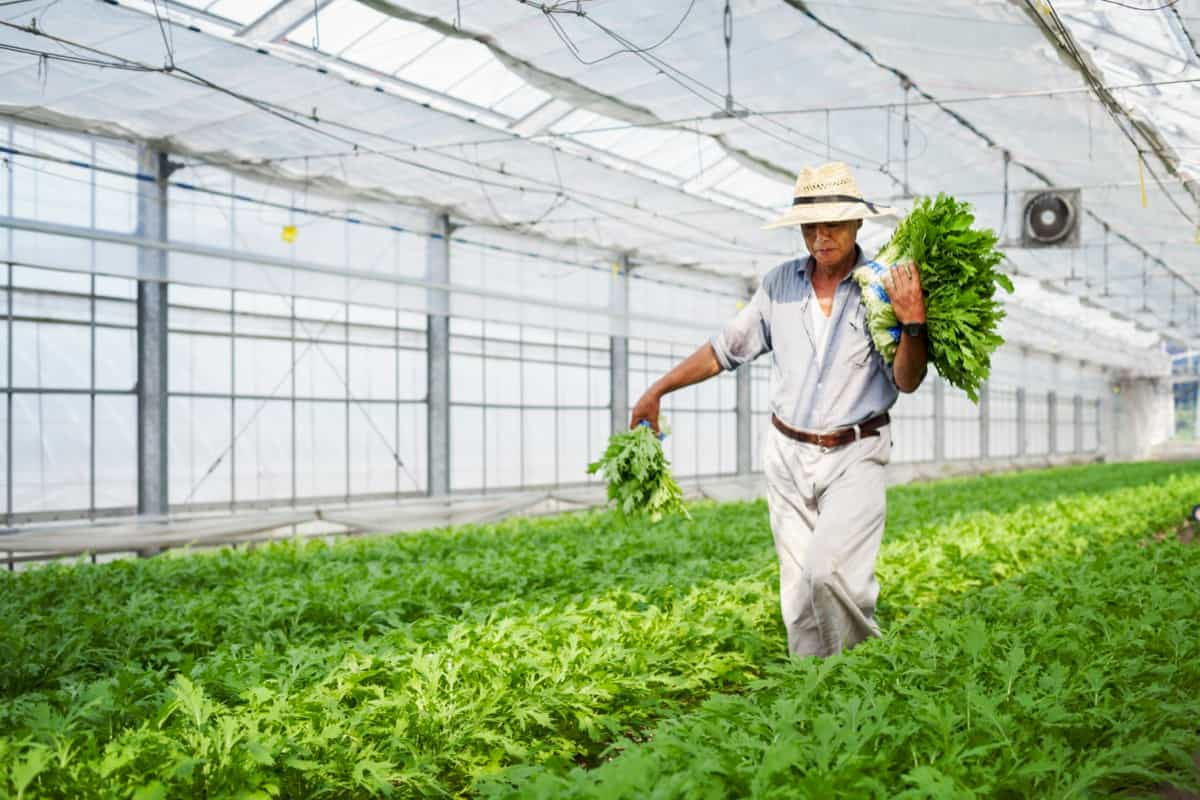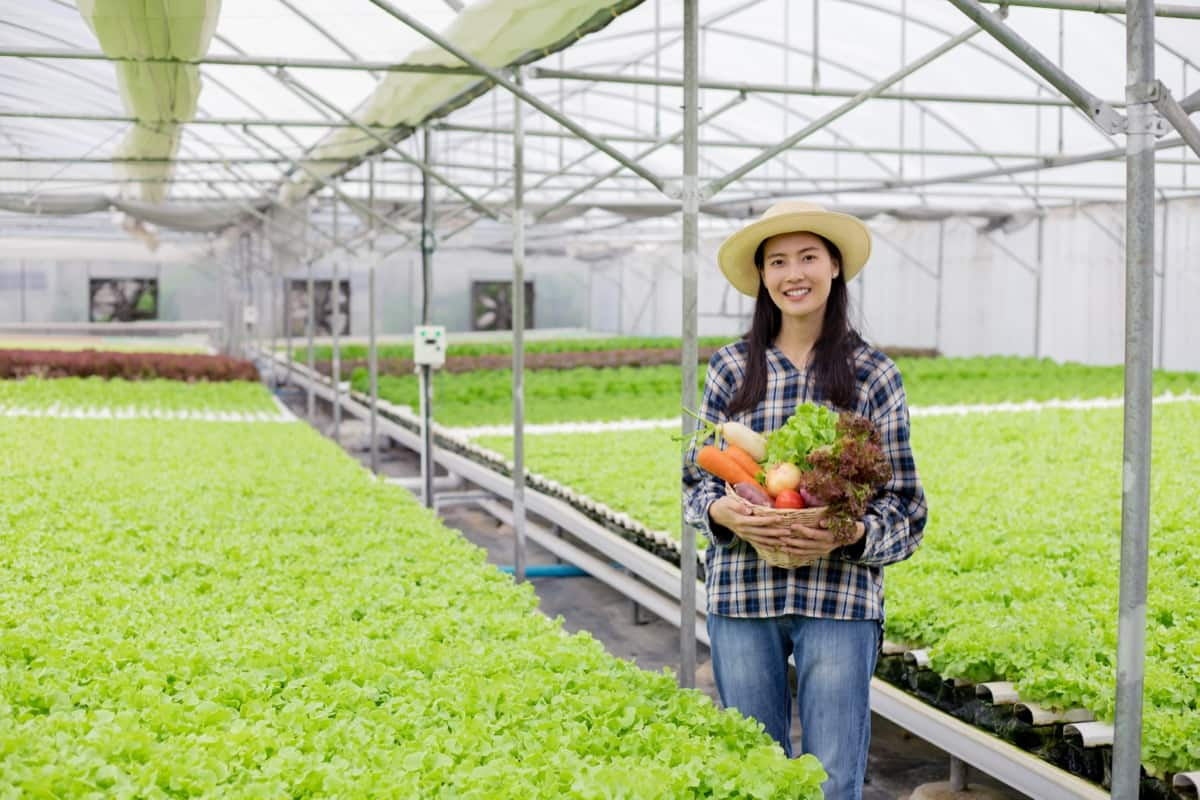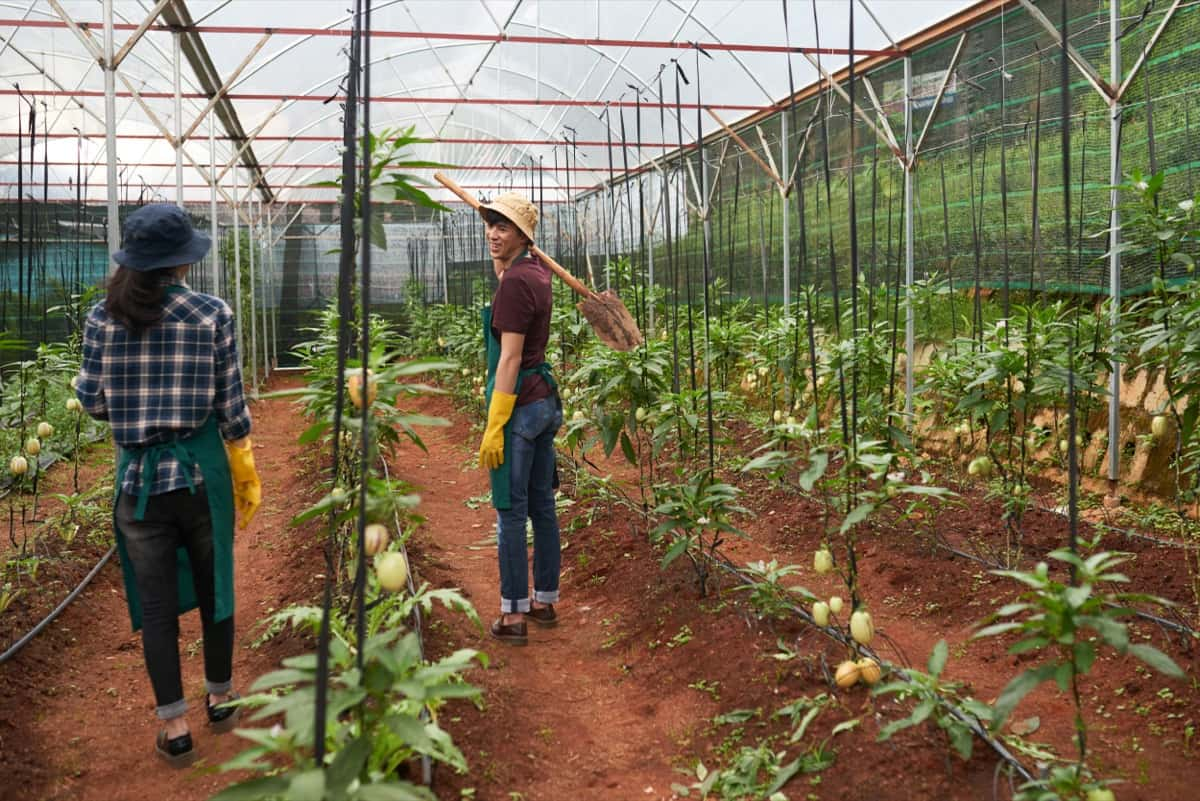In recent years, the Arunachal Pradesh government has been working hard to promote the development of greenhouse farming to boost economic growth and provide food security. Greenhouse farming is an agricultural practice that involves growing crops in controlled conditions with the help of greenhouses.

How to Start Greenhouse Farming in Arunachal Pradesh
What is Greenhouse Farming?
Greenhouse farming is where crops are grown under controlled environmental conditions for optimal growth and yield. The main objectives of greenhouse farming are to protect crops from inclement weather conditions and pests and to provide a favorable environment for plant growth.
Greenhouses are typically made up of transparent or semi-transparent material, such as glass or plastic, which allows sunlight to enter and warmth to be trapped inside. This creates an ideal setting for plants to grow, as they receive the right amount of light and heat needed for photosynthesis and growth.
Objectives of Greenhouse Framing in Arunachal Pradesh
- The main objectives of greenhouse farming are to protect crops from inclement weather conditions and pests and to provide a favorable environment for plant growth.
- Greenhouses are typically made up of transparent or semi-transparent material, such as glass or plastic, which allows sunlight to enter and warmth to be trapped inside. This creates an ideal setting for plants to grow, as they receive the right amount of light and heat needed for photosynthesis and growth.
- Greenhouse farming has grown in popularity over the past few years because it’s a more environmentally-friendly way to produce food and offers several advantages over traditional farming.
- It is a type of agriculture where crops are grown under controlled conditions in a greenhouse. Greenhouse farming can year-round produce vegetables, fruits, flowers, and other plants. Arunachal Pradesh has a humid climate, which is well suited for greenhouse farming. By protecting plants from extreme weather conditions and providing them with optimal ventilation levels, light, temperature, and nutrient availability, growers can increase yields and ensure crop quality.
In case you missed it: How to Start Poultry Farming in Arunachal Pradesh: Business Plan, Set-up Cost, Profit, and Requirements

Greenhouse Vegetable Production in Arunachal Pradesh
Greenhouse vegetable production in Arunachal Pradesh is a rapidly growing industry. This is because the state has a conducive greenhouse-farming climate, and the government supports this activity. There are many benefits to greenhouse vegetable production, including increased yield, improved quality, and extended shelf life. In addition, greenhouse farms can use less water than traditional open-field farms. They can also help control pests and diseases, a major problem in tropical climates like Arunachal Pradesh.
Greenhouse vegetable production is an excellent way to improve the livelihoods of small-scale farmers in the state. It provides them with a more stable income and access to better markets for their produce. The government is working hard to promote this sector and provide training and support to farmers to benefit from this growing industry.
Benefits of Greenhouse Farming in the Arunachal Pradesh
- Greenhouse farming has several advantages over traditional farming practices. Greenhouses provide a controlled environment for crops, which can result in higher yields and better-quality produce. They also protect crops from extreme weather conditions, pests, and diseases.
- Greenhouse farming is an important part of Arunachal Pradesh’s agricultural sector. The state’s climate is well suited for greenhouse cultivation, and the state government has been promoting the adoption of greenhouses by farmers.
- Greenhouse farming in Arunachal Pradesh has increased crop production, improved incomes for farmers, and created jobs in the construction and operation of greenhouse farms.
In case you missed it: Greenhouse Farming in Gujarat: Crops, 1 Acre Greenhouse Cost, Subsidy, and Loans

The Future of Greenhouse Farming in Arunachal Pradesh
Greenhouse farming is an agricultural production system that involves growing crops in controlled environments. It is a type of intensive agriculture that allows farmers to produce more food with fewer inputs. Greenhouse farms can be found in many parts of the world, including India. Greenhouse farming is becoming increasingly popular in Arunachal Pradesh due to its benefits. The state has a tropical climate, which is favorable for greenhouse farming.
Moreover, the state government provides financial assistance to farmers who want to set up greenhouses. This has made it easier for farmers to adopt this technology. The future of greenhouse farming in Arunachal Pradesh looks bright. With the right support from the government and private sector, more farmers will be able to benefit from this type of agriculture. This will lead to increased food production and improved livelihoods for farmers.
Is Greenhouse Farming Profitable in Arunachal Pradesh
Greenhouse farming can be quite profitable in Arunachal Pradesh if done correctly. The key to success with greenhouse farming in this region is to choose the right crops to grow. Some of the most popular and profitable crops to grow in greenhouses in Arunachal Pradesh include Tomatoes, Cucumbers, Peppers, and Eggplants. These crops are all very popular in the region and can fetch a good price at the market.
Another important factor to consider when doing greenhouse farming in Arunachal Pradesh is the climate. The climate in this region is very conducive to greenhouse farming, with warm temperatures and plenty of sunlight. Greenhouse farming is one of the most efficient and cost-effective ways to maximize crop production and yields in a region like Arunachal Pradesh.
Crops are Grown Under Greenhouses in Arunachal Pradesh
- Greenhouse farming in Arunachal Pradesh is a relatively new phenomenon, but it is already proving to be a very successful form of agriculture in the region. Crops grown in greenhouses include vegetables, fruits, and flowers. The advantages of greenhouse farming include that crops can be grown year-round, protected from harsh weather conditions, and pests and diseases are much easier to control.
- The farm grows various crops, including Tomatoes, Cucumbers, Capsicums, Eggplants, and leafy greens. The farm also produces flowers for the cut-flower market.
In case you missed it: Glasshouse Farming: For Increased Yields and Reduced Pesticide Use

What are the Different Greenhouse Farms in Arunachal Pradesh?
- The most common type of greenhouse is the plastic tunnel greenhouse. These are typically made of PVC or polyethylene, offering good protection from the elements while allowing plenty of light.
- There are different types of greenhouses based on their structure, function, and materials. The most common type is the plastic tunnel greenhouse, made of a metal frame covered with plastic sheeting. These are typically used for growing vegetables or flowers. Another common type is the wooden greenhouse, made with a wood frame and glass panels. These are often used for starting plants from seedlings or cuttings.
- Other greenhouses include fabric-covered structures, metal-framed greenhouses, and portable greenhouses. Fabric-covered greenhouses can be made from various materials, including PVC, polyethylene, or nylon. Metal-framed greenhouses are usually made from aluminum or steel. Portable greenhouses are typically made from plastic or metal and can be moved around as needed.
- Another type of greenhouse is the glasshouse. These are more expensive to build and maintain, but they offer superior protection from the elements and can be better controlled for temperature and humidity.
Are Greenhouse Farms Profitable?
Yes, greenhouse farms can be quite profitable. They are often more profitable than traditional farming methods. This is because greenhouse farmers can control the environment in which their plants grow, meaning they can optimize conditions for plant growth. Additionally, greenhouses allow farmers to extend the growing season and produce crops year-round, which can lead to higher profits.
Cost to Build a Greenhouse in Arunachal Pradesh
The state has a tropical climate ideal for growing various crops, and the greenhouse allows farmers to extend the growing season and get greater yields. The cost of building a greenhouse will vary depending on the structure size and type you want, but it is generally not an inexpensive investment. The greenhouse set-up cost can range from Rs. 5 lakhs to Rs. 10 lakhs per acre, depending on the greenhouse farm size and type.
Can You Grow a Greenhouse Crops Year-Round in Arunachal Pradesh?
Yes, you can grow in a greenhouse year-round in Arunachal Pradesh. The climate is well suited for greenhouse farming, and many greenhouses operate in the state. However, you must take precautions to ensure your plants stay healthy and productive. Firstly, choosing a location for your greenhouse with plenty of sunlight is important. If possible, select a spot that also has good ventilation.
Next, you must purchase or build a big greenhouse to accommodate your plants. Ensure the structure is sturdy and has proper ventilation and windows for air circulation. Once your greenhouse is set up, you can start planting. You can grow various crops in your greenhouse, but selecting varieties well-suited to the climate is important. Tomatoes, peppers, cucumbers, and eggplants are all good choices. You must also water your plants regularly and fertilize them as needed.
In case you missed it: Greenhouse Farming in Uttarakhand: Crops, 1 Acre Greenhouse Cost, Subsidy, and Loans

Number of Greenhouses in Arunachal Pradesh
- According to the latest agricultural census, there are 1,842 greenhouses in Arunachal Pradesh. This number has steadily increased over the past few years as more and more farmers realize the benefits of greenhouse farming.
- Greenhouse farming allows farmers to grow crops all year round, regardless of the weather outside. This is especially beneficial in places like Arunachal Pradesh, where the climate can be unpredictable. With a greenhouse, farmers can control the temperature, humidity, and amount of light that their plants receive, ensuring that they always have the perfect growing conditions.
- In addition to being able to farm year-round, greenhouses also protect crops from pests and diseases. This is important in a place like Arunachal Pradesh, where many crops are at risk from pests and disease due to the high humidity.
Pest and Disease Management in Greenhouses
Pests and diseases are a serious threat to greenhouse crops. Greenhouse farmers in Arunachal Pradesh take various measures to prevent and control pests and diseases. The most common pests that attack greenhouse crops are aphids, whiteflies, thrips, and mites. These problems can be controlled by using insecticides. However, applying the right insecticide properly is important to avoid harming plants.
Diseases of greenhouse crops include fungal diseases such as powdery mildew and botrytis and bacterial diseases such as Pseudomonas syringae pv. Tomato and viral diseases such as the cucumber mosaic virus. These crop diseases can be controlled using fungicides, bactericides, and virucides. Choosing the right products and applying them according to the instructions is important to avoid harming the plants.
Greenhouse Loans and Subsidies in Arunachal Pradesh
Greenhouse loans and subsidies are available in Arunachal Pradesh for farmers who want to set up greenhouses. The government offers a 50% subsidy for setting up a greenhouse and provides loans at subsidized interest rates. Farmers can avail of these benefits by applying to the Agricultural Development Officer in their district.
In case you missed it: 15 Cover Crops for Raised Beds: When to Plant, Best Winter and No-till Cover Crops

Key Rules for Starting Greenhouse Farm in Arunachal Pradesh
- The location of your greenhouse should get plenty of sunlight and have good drainage. Avoid locations that are prone to flooding or landslides.
- Good ventilation is important for preventing heat build-up and promoting plant growth. Ensure your greenhouse has adequate ventilation by installing vents or fans.
- Temperature, humidity, and light levels can all be controlled inside a greenhouse. Use thermostats, humidifiers, dehumidifiers, and grow lights as needed to create the ideal environment for your plants.
- Farmers must have a thorough understanding of the climate and weather conditions in the region. They must also be familiar with crops grown successfully in greenhouses.
- In addition, farmers must carefully select the location of their greenhouse operation. The site must have adequate sunlight exposure and water availability. It should also be situated near markets where the crops can be sold.
- Farmers must implement proper management practices to ensure their greenhouse operation is productive and profitable. This includes maintaining strict control over pests and diseases and ensuring that the plants have access to the necessary nutrients for optimal growth.
Create a Greenhouse Business Plan in Arunachal Pradesh
- Knowing your target market will help you develop marketing strategies to attract customers.
- To succeed, you must know how much money you’ll need to start and operate your greenhouse business. Make realistic estimates for equipment and labor costs and projected income from sales.
- Research the local market for potential customers and understand their needs. Also, be sure to set aside money for unexpected expenses that may come up along the way.
- Develop a business model and operations plan based on your research findings.
- Create a marketing strategy to reach your target market and promote your business.
- Conduct a financial analysis to determine your greenhouse business’s start-up costs and ongoing expenses.
- Prepare a detailed business plan that includes all of the above information and your goals and objectives for starting a greenhouse farm in Arunachal Pradesh.
Challenges of Greenhouse Farming in Arunachal Pradesh
The challenges of greenhouse farming in Arunachal Pradesh are many and varied. The region is hilly and mountainous, with a tropical climate that can be very hot and humid. There is also a lot of rainfall, making it difficult to get adequate water for greenhouse plants. The soil is also very poor in nutrients, making it hard to grow anything without using fertilizers. Pests and diseases are also a big problem in the region, as there are no natural predators to keep them under control.
In case you missed it: 15 Potting Soil Mixes for Bonsai Plants: Best List

Conclusion
Greenhouse farming in Arunachal Pradesh has a long and rich history. The state has been home to many traditional greenhouse farms for centuries, and the practice continues today. Greenhouse farming allows farmers to grow crops in controlled environments, protected from extreme weather conditions and pests.
- Types of Pesticides Used in Agriculture: A Beginner’s Guide
- Economical Aquaculture: A Guide to Low-Budget Fish Farming
- 15 Common Planting Errors That Can Doom Your Fruit Trees
- How to Make Houseplants Bushy: Effective Tips and Ideas
- Innovative Strategies for Boosting Coconut Pollination and Yield
- Pollination Strategies for Maximum Pumpkin Yield
- The Complete Guide to Chicken Fattening: Strategies for Maximum Growth
- Natural Solutions for Tulip Problems: 100% Effective Remedies for Leaf and Bulb-Related Issues
- Revolutionizing Citrus Preservation: Towards a Healthier, Greener Future
- Natural Solutions for Peony Leaf and Flower Problems: 100% Effective Remedies
- Maximizing Profits with Avocado Contract Farming in India: A Comprehensive Guide
- Natural Solutions for Hydrangea Problems: 100% Effective Remedies for Leaf and Flowers
- The Ultimate Guide to Choosing the Perfect Foliage Friend: Bringing Life Indoors
- From Sunlight to Sustainability: 15 Ways to Use Solar Technology in Agriculture
- The Ultimate Guide to Dong Tao Chicken: Exploring from History to Raising
- The Eco-Friendly Makeover: How to Convert Your Unused Swimming Pool into a Fish Pond
- Mastering the Art of Delaware Chicken Farming: Essentials for Healthy Backyard Flocks
- 20 Best Homemade Fertilizers for Money Plant: DIY Recipes and Application Methods
- How to Craft a Comprehensive Free-Range Chicken Farming Business Plan
- Brighten Your Flock: Raising Easter Egger Chickens for Beauty and Bounty
- How to Optimize Your Poultry Egg Farm Business Plan with These Strategies
- Subsidy for Spirulina Cultivation: How Indian Government Schemes Encouraging Spirulina Farmers
- Ultimate Guide to Raising Dominique Chickens: Breeding, Feeding, Egg-Production, and Care
- Mastering the Art of Raising Jersey Giant Chickens: Care, Feeding, and More
- Ultimate Guide to Raising Legbar Chickens: Breeding, Farming Practices, Diet, Egg-Production
- How to Raise Welsummer Chickens: A Comprehensive Guide for Beginners
- How to Protect Indoor Plants in Winter: A Comprehensive Guide
- Ultimate Guide to Grow Bag Gardening: Tips, Tricks, and Planting Ideas for Urban Gardeners
- Guide to Lotus Cultivation: How to Propagate, Plant, Grow, Care, Cost, and Profit
- Agriculture Drone Subsidy Scheme: Government Kisan Subsidy, License, and How to Apply Online
- Ultimate Guide to Raising Araucana Chickens: Breed Profile, Farming Economics, Diet, and Care
- Bringing Hydroponics to Classroom: Importance, Benefits of Learning for School Students
- Ultimate Guide to Raising Polish Chickens: Breed Profile, Farming Economics, Diet, and Care
- Ultimate Guide to Raising Australorp Chickens: Profile, Farming Economics, Egg Production, Diet, and Care
- Silkie Chicken Farming: Raising Practices, Varieties, Egg Production, Diet, and Care
- Sussex Chicken Farming: Raising Practices, Varieties, Egg Production, Diet and Care